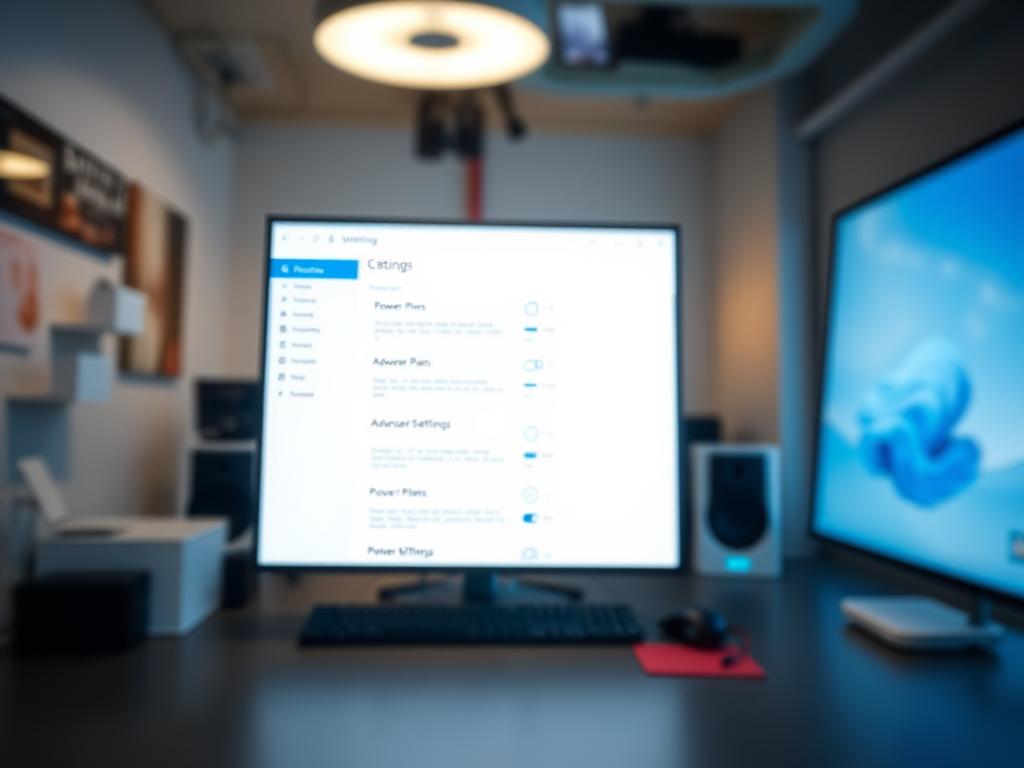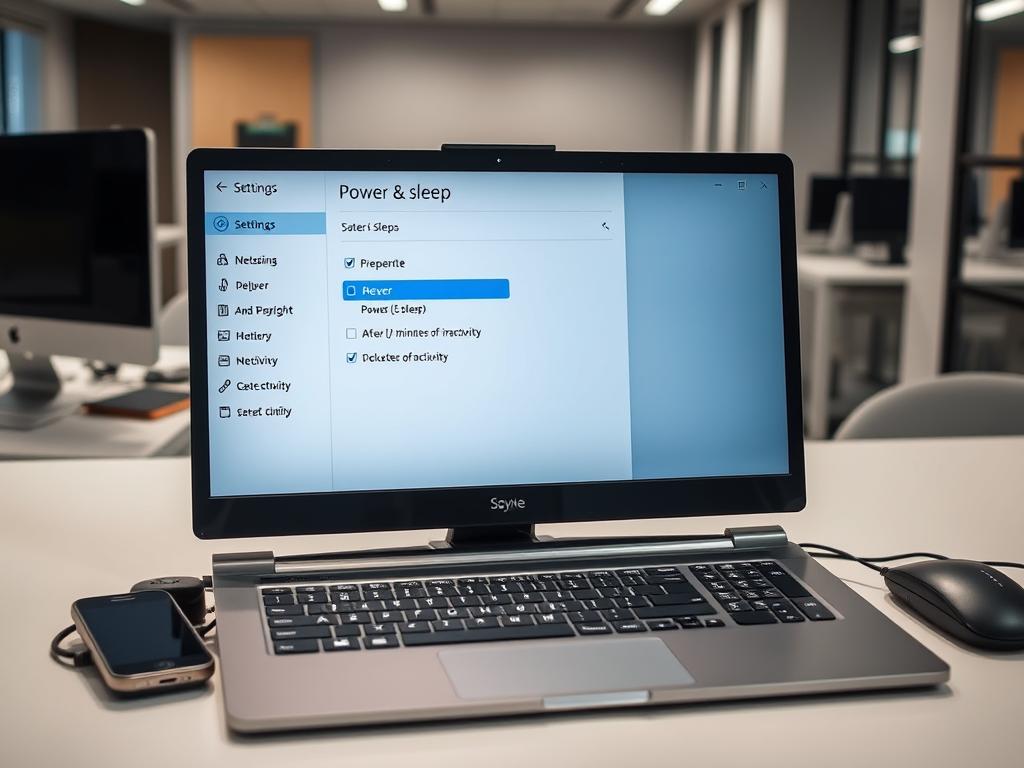Table of Contents
Managing your PC’s sleep settings is vital for uninterrupted work. Users often struggle with sleep mode disrupting important tasks. Preventing sleep mode ensures continuous computer operation.
Windows PCs are set to save energy by sleeping after inactivity. This can be frustrating when you need your computer running. Disabling sleep settings offers a practical solution for uninterrupted system performance.
Controlling sleep settings is crucial for various tasks. These include important projects, server applications, and remote desktop connections. This guide will help you keep your system active when needed.
We’ll explore different methods to stop automatic sleep mode. You’ll learn about Windows settings and power plan configurations. We’ll also cover third-party solutions for better power management control.
Understanding PC Sleep Mode and Its Purpose
PC sleep mode is a clever power-saving feature. It keeps your computer’s state whilst using less energy. You can quickly resume work without long waits.
In sleep mode, Windows saves open apps and documents. It uses less power but keeps your work ready. This smart technique balances energy use and convenience.
What Triggers Sleep Mode
Several factors can trigger PC sleep settings in Windows:
- Periods of user inactivity
- Closing laptop lid
- Manually selecting sleep option
- Configured power plan timers
Default Sleep Settings in Windows
Windows has preset power management settings for sleep mode. You can adjust these to fit your needs and power usage preferences.
| Sleep Mode Type | Power Consumption | Resume Time |
|---|---|---|
| Standard Sleep | 1-2 watts | Few seconds |
| Hibernate | 0 watts | Several minutes |
Benefits and Drawbacks of Sleep Mode
PC sleep mode offers many benefits, but it’s important to know its limits:
- Advantages:
- Quick system resume
- Energy conservation
- Preserves current working state
- Potential Drawbacks:
- Possible interruption of background tasks
- Slight power consumption
- Potential compatibility issues with peripherals
How to Stop My PC from Going to Sleep Using Windows Settings
Is your PC entering sleep mode unexpectedly? You can adjust Windows settings to prevent this. Windows 10 and 11 computers usually sleep automatically to save power.
But you can change these settings to avoid interruptions. Here’s how to keep your PC awake and tweak Windows sleep settings.
- Press Windows + I keys to open Settings
- Navigate to System > Power & Battery
- Locate the sleep configuration options
Windows offers several ways to customise sleep behaviour:
- Set “When plugged in, put my device to sleep after” to Never
- Choose “Turn off my screen after” as Never
- Adjust battery power settings independently
| Device Type | Sleep Options | Recommended Setting |
|---|---|---|
| Desktop PC | 2 primary options | Disable sleep when plugged in |
| Laptop/Tablet | 4 configurable options | Customise based on power source |
For tech-savvy users, Microsoft PowerToys offers an Awake utility. This tool lets you quickly toggle sleep mode from the taskbar.
Pro tip: Always consider your specific work requirements and battery life when adjusting sleep settings.
Adjusting Power Plan Settings Through Control Panel
Power settings can boost your computer’s performance and battery life. Windows 10 offers flexible options to customise power plan settings via the Control Panel. This gives users control over their system’s energy use.

Windows has multiple power plans for different needs. Most computers come with three default options:
- Balanced: Recommended for most users
- Power Saver: Reduces energy consumption
- High Performance: Maximises system capabilities
Accessing Power Options
To adjust your control panel sleep settings, follow these steps:
- Open the Control Panel
- Select System and Security
- Click on Power Options
- Choose your current power plan
Modifying Sleep Timers
Customising sleep timers optimises your computer’s power management. Users can set different time intervals for various actions.
These include screen turn-off and computer sleep for both battery and plugged-in modes.
- Screen turn-off when on battery
- Computer sleep when on battery
- Screen turn-off when plugged in
- Computer sleep when plugged in
Pro tip: For laptops, consider creating separate settings for battery and plugged-in modes.
Saving Your Custom Power Settings
After adjusting your settings, remember to save changes. Windows will apply your custom power plan automatically. This ensures optimal performance tailored to your needs.
Using the Windows Settings App for Sleep Prevention
Stopping your PC from sleeping is easy with the Windows Settings app. It offers a user-friendly way to manage power and sleep options.
This modern interface lets you control these settings with just a few clicks.
To find sleep prevention settings in the Windows Settings app, follow these steps:
- Press Windows + I keys to open Settings
- Click on System menu
- Select Power & sleep section
In the Power & sleep options, you’ll see two main areas to configure:
- Screen timeout settings
- Sleep mode configurations
To stop sleep mode completely, choose “Never” for both On battery power and When plugged in. This keeps your Windows device active during important tasks.
| Power Source | Sleep Prevention Setting |
|---|---|
| Battery Power | Never |
| Plugged In | Never |
After changing these settings, click “Apply” to save your choices. This will ensure your sleep prevention preferences are active.
Advanced Methods Using Group Policy Editor
The Group Policy Editor offers precise control over power management. It’s a powerful tool for system administrators to implement advanced sleep settings. This method goes beyond standard Windows configurations for managing system sleep parameters.
Professional users can access these advanced settings through specific configuration paths. The Group Policy Editor allows for customised sleep behaviour across Windows systems. It provides robust system administration capabilities for configuring sleep-related policies.
Configuring System Sleep Timeout
To configure system sleep timeout using Group Policy Editor, follow these steps:
- Open Group Policy Editor
- Navigate to Computer Configuration → Policies → Administrative Templates → System → Power Management
- Locate Sleep Settings section
- Enable “Specify system sleep timeout (plugged in)” policy
- Set value to 0 seconds to disable sleep timer
Managing Unattended Sleep Parameters
Unattended sleep settings offer extra control for system administrators. These parameters help prevent unexpected system interruptions during critical processes. Configuring them ensures smooth operation during important tasks.
- Enable “Specify unattended sleep timeout (plugged in)” policy
- Set timeout to 0 seconds for complete sleep prevention
- Verify settings apply to all user accounts
Hibernate Settings Management
Hibernate settings can be managed through similar Group Policy configurations. Adjust these settings carefully to match your specific system requirements. Consider your usage patterns when making changes.
Note: Group Policy Editor access requires Windows Pro or Enterprise editions.
Third-Party Solutions to Keep Your PC Awake
PC awake software offers clever ways to stop your computer from sleeping. These tools help when Windows settings aren’t enough. They’re great for people who need their computers to stay on all the time.
Caffeine is a popular choice. It’s small and easy to use. It keeps your PC awake by pretending to press keys. Microsoft PowerToys Awake is another good option for Windows 10 and 11.
Mouse Jiggler is another tool that keeps screens active. These programs are useful for big downloads or long updates. They trick your computer into thinking you’re still using it.
Over 100,000 people have reviewed various sleep prevention apps. They’re popular with professionals who manage multiple computers. These tools help keep work flowing smoothly.
Choosing the right tool depends on what you need. Some use very little of your computer’s power. Others can turn on your PC from far away. These apps fill the gap between Windows settings and what users really need.
FAQ
What is sleep mode and why does my computer enter it automatically?
Sleep mode is a power-saving state that temporarily suspends system activity. It kicks in after a period of inactivity to save energy. Triggers include keyboard or mouse inactivity and specific power management settings.
Can preventing sleep mode impact my computer’s performance or battery life?
Disabling sleep mode can significantly reduce battery life on laptops. It also increases power consumption on desktop computers. Consider your specific needs when balancing performance with energy efficiency.
What are the primary methods to prevent my PC from going to sleep?
You can adjust Windows power settings through the Control Panel or Settings app. The Group Policy Editor offers additional options for some versions. Third-party software like Caffeine can also keep your system awake.
Are there risks associated with preventing sleep mode?
Risks include increased power use and reduced battery life for laptops. It may also cause more heat generation. Preventing sleep mode might interfere with automatic updates or scheduled maintenance tasks.
How do different power plans affect sleep settings?
Windows offers multiple power plans with varying sleep and timeout settings. These include Balanced, Power Saver, and High Performance. Each plan has different default configurations that affect when your computer enters sleep mode.
Can I set different sleep settings for plugged-in and battery-powered scenarios?
Yes, Windows allows separate sleep settings for plugged-in and battery-powered modes. This lets you manage power differently when using a laptop on battery versus when plugged in.
What limitations exist when preventing sleep mode on different Windows versions?
Sleep mode prevention methods may vary between Windows 10 and 11. Some advanced settings might be in different places. Enterprise versions like Windows Pro offer extra Group Policy options not found in home editions.
Are third-party sleep prevention tools safe to use?
Reputable tools like Caffeine are generally safe. Download from official sources and check developer credentials. Be aware of potential system resource usage. Always review permissions and read user reviews before installing.









